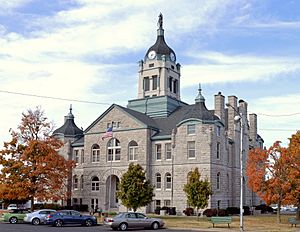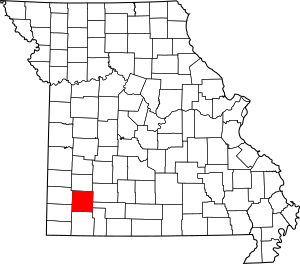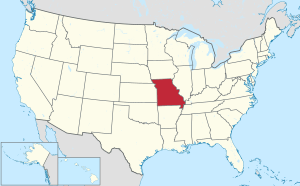Lawrence County, Missouri facts for kids
Quick facts for kids
Lawrence County
|
|
|---|---|

The Lawrence County Courthouse in Mt. Vernon
|
|

Location within the U.S. state of Missouri
|
|
 Missouri's location within the U.S. |
|
| Country | |
| State | |
| Founded | February 14, 1845 |
| Named for | James Lawrence |
| Seat | Mount Vernon |
| Largest city | Monett |
| Area | |
| • Total | 613 sq mi (1,590 km2) |
| • Land | 612 sq mi (1,590 km2) |
| • Water | 1.6 sq mi (4 km2) 0.3% |
| Population
(2020)
|
|
| • Total | 38,001 |
| • Density | 61.99/sq mi (23.935/km2) |
| Time zone | UTC−6 (Central) |
| • Summer (DST) | UTC−5 (CDT) |
| Congressional district | 7th |
Lawrence County is a county in the southwest part of Missouri, a U.S. state. It's located in the beautiful Ozarks region. In 2020, about 38,001 people lived here.
The main city and county seat is Mount Vernon. Lawrence County was created in 1845. It was named after James Lawrence. He was a brave naval officer from the War of 1812. He is famous for his battle cry, "Don't give up the ship!"
Before this county, there was an older Lawrence County. It was set up in 1815. That county covered parts of what is now southern Missouri and northern Arkansas. When the Arkansas Territory was formed in 1819, some of that land became Lawrence County, Arkansas.
In 1818, Missouri divided its part of the old county. It became Wayne County and Madison County. As more people moved in, these counties were split again. This is how the current Lawrence County was formed.
Contents
History of People in Lawrence County
After the Reconstruction era, life became very hard for African Americans in southwest Missouri. White groups in Lawrence and other counties attacked them. They wanted to force African Americans to leave the area.
In 1894, an African-American man was killed in Verona, Missouri. His name was not recorded. Later, in 1901, three men were killed by a white mob in Pierce City. This is the county seat of Lawrence County. The mob also burned some homes belonging to black families.
About 300 African Americans, from roughly 30 families, were forced to leave Pierce City. White people took over their properties. The African Americans were never paid for what they lost.
Because of these unfair events, many African Americans left Southwest Missouri. This happened in the early 1900s. These acts of violence and threats were part of a pattern. They aimed to scare and remove African Americans from the area. This pattern lasted from 1894 to 1909.
Geography of Lawrence County
Lawrence County covers about 613 square miles. Most of this area, 612 square miles, is land. Only a small part, about 1.6 square miles, is water. This is about 0.3% of the total area.
The Ozark Cavefish National Wildlife Refuge is a special place here. It helps protect unique cavefish.
Neighboring Counties
Lawrence County shares borders with several other counties:
- Dade County (to the north)
- Greene County (to the northeast)
- Christian County (to the southeast)
- Stone County (to the southeast)
- Barry County (to the south)
- Newton County (to the southwest)
- Jasper County (to the west)
Main Roads in Lawrence County
Several important highways pass through Lawrence County:
 Interstate 44
Interstate 44 U.S. Route 60
U.S. Route 60 U.S. Route 66 (This famous road was used from 1926 to 1985)
U.S. Route 66 (This famous road was used from 1926 to 1985) Route 39
Route 39 Route 96
Route 96 Route 97
Route 97 Route 266
Route 266
Population and People
| Historical population | |||
|---|---|---|---|
| Census | Pop. | %± | |
| 1850 | 4,859 | — | |
| 1860 | 8,840 | 81.9% | |
| 1870 | 12,977 | 46.8% | |
| 1880 | 17,583 | 35.5% | |
| 1890 | 26,228 | 49.2% | |
| 1900 | 31,662 | 20.7% | |
| 1910 | 26,583 | −16.0% | |
| 1920 | 24,211 | −8.9% | |
| 1930 | 23,774 | −1.8% | |
| 1940 | 24,637 | 3.6% | |
| 1950 | 23,420 | −4.9% | |
| 1960 | 23,260 | −0.7% | |
| 1970 | 24,585 | 5.7% | |
| 1980 | 28,973 | 17.8% | |
| 1990 | 30,236 | 4.4% | |
| 2000 | 35,204 | 16.4% | |
| 2010 | 38,634 | 9.7% | |
| 2020 | 38,001 | −1.6% | |
| U.S. Decennial Census 1790-1960 1900-1990 1990-2000 2010 |
|||
In 2000, there were 35,204 people living in Lawrence County. There were 13,568 households. About 9,728 of these were families. The county had about 57 people per square mile.
Most people in the county were White (95.68%). There were also smaller groups of Black or African American, Native American, and Asian people. About 3.39% of the population was Hispanic or Latino.
About 33.60% of households had children under 18. Many households (58.90%) were married couples. The average household had 2.55 people. The average family had 3.03 people.
The population was spread out by age. About 27.20% were under 18. The median age was 37 years old. This means half the people were younger and half were older.
The average income for a household was $31,239. For a family, it was $36,846. About 14.10% of the population lived below the poverty line. This included 19.50% of those under 18.
2020 Census Information
The 2020 census showed the following racial makeup for Lawrence County:
| Race | Number | Percent |
|---|---|---|
| White (Not Hispanic) | 32,401 | 85.26% |
| Black or African American (Not Hispanic) | 134 | 0.35% |
| Native American (Not Hispanic) | 333 | 0.9% |
| Asian (Not Hispanic) | 171 | 0.45% |
| Pacific Islander (Not Hispanic) | 40 | 0.11% |
| Other/Mixed (Not Hispanic) | 1,935 | 5.1% |
| Hispanic or Latino | 2,987 | 7.86% |
Schools and Learning
Lawrence County has many schools for students of all ages.
Public Schools
- Aurora R-VIII School District – Aurora
- Pate Early Childhood Center (Preschool-2nd grade)
- Robinson Elementary School (3rd-4th grade)
- Robinson Intermediate School (5th-6th grade)
- Aurora Junior High School (7th-8th grade)
- Aurora High School (9th-12th grade)
- Marionville R-IX School District – Marionville
- Marionville Elementary School (Preschool-5th grade)
- Marionville Middle School (6th-8th grade)
- Marionville High School (9th-12th grade)
- Miller R-II School District – Miller
- Central Elementary School (Kindergarten-6th grade)
- Miller High School (7th-12th grade)
- Mt. Vernon R-V School District – Mt. Vernon
- Mt. Vernon Elementary School (Preschool-2nd grade)
- Mt. Vernon Intermediate School (3rd-5th grade)
- Mt. Vernon Middle School (6th-8th grade)
- Mt. Vernon High School (9th-12th grade)
- Pierce City R-VI School District – Pierce City
- Central Elementary School (Preschool-5th grade)
- Pierce City Middle School (6th-8th grade)
- Pierce City High School (9th-12th grade)
- Verona R-VII School District – Verona
- Verona Elementary School (Preschool-6th grade)
- Verona High School (7th-12th grade)
Private Schools
- Aurora Christian Academy – Aurora (Kindergarten-12th grade) – A Baptist school with a focus on special education.
- Harvest Christian Academy – Aurora (Kindergarten-12th grade) – A Nondenominational Christian school.
- Round Grove Christian Academy – Miller (Preschool-9th grade) – A Baptist school.
- Trinity Lutheran School – Freistatt (Preschool-8th grade) – A Lutheran school.
- St. Mary’s Catholic School – Pierce City (Preschool-8th grade) – A Roman Catholic school.
Public Libraries
- Barry-Lawrence Regional Library serves the area.
Towns and Communities
Lawrence County is home to several cities, villages, and other communities.
Cities
- Aurora
- Marionville
- Miller
- Monett
- Mount Vernon (This is the county seat)
- Pierce City
- Stotts City
- Verona
Villages
Census-designated place
- Chesapeake (This is a community that the census bureau tracks, but it's not an official city or village.)
Other Unincorporated Places
These are smaller communities that are not officially cities or villages.
See also
 In Spanish: Condado de Lawrence (Misuri) para niños
In Spanish: Condado de Lawrence (Misuri) para niños

